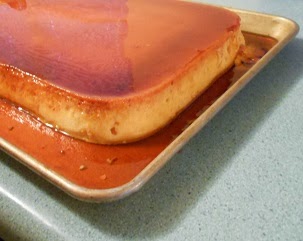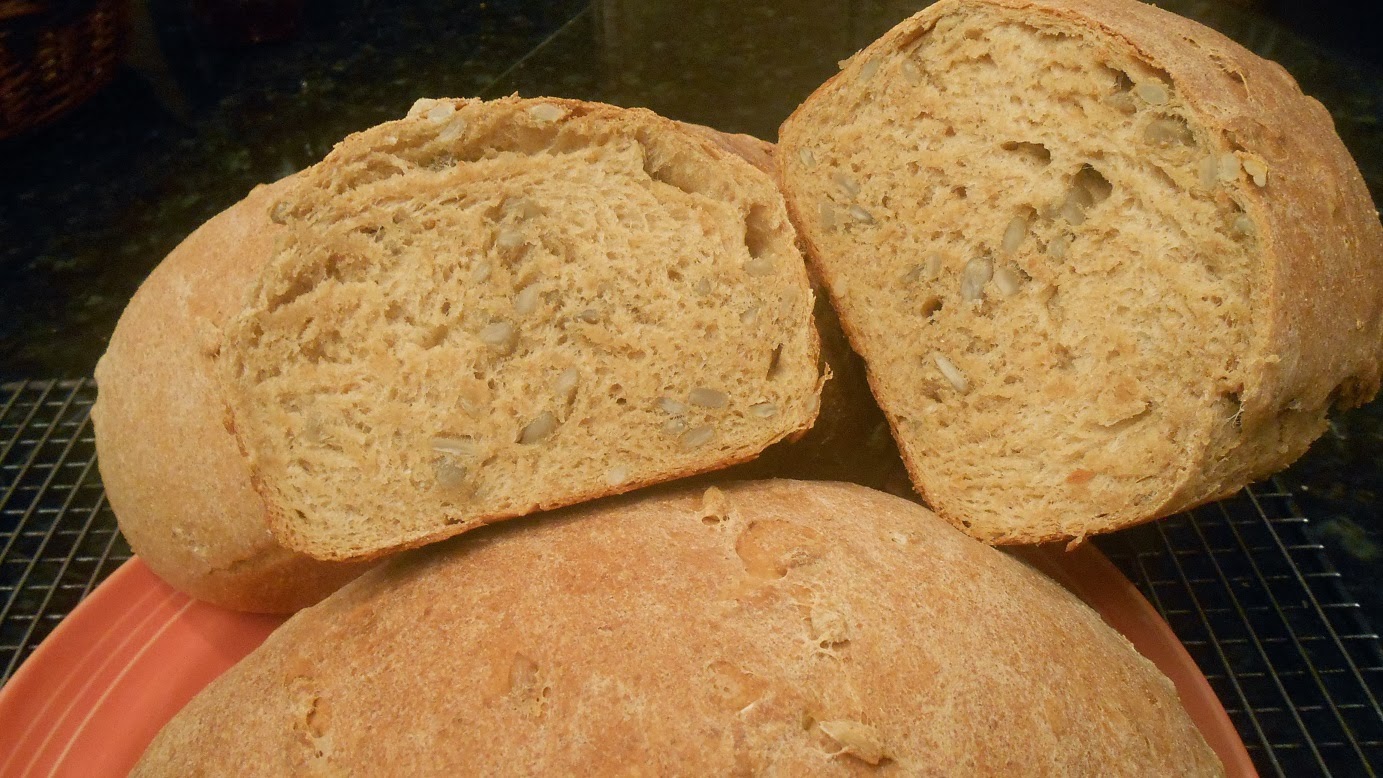Flan
I learned to make flan from my friend, Ligia, in Virginia. This is one of my most favorite desserts. You have to remove the "chalazae" (white part that attaches the yolk to the membrane) from each egg so you don't end up with clumps of egg white in the final product (or as I've discovered, just strain the batter as you pour into the pan. Also, a flan pan is basically just a flatter, wider bundt cake pan. In the picture below I doubled the recipe and put it in a large 9 x 13 pan. Just be careful and don't let the burnt sugar drip on you or you'll have a bad burn and scar forever! Trust me on this one, I know what I'm talking about. 2/8/19--As time has gone by, I've made a few adjustments to the sugar syrup and baking method from the original recipe. Practice makes perfect! 12/2-11/22--so much adjusting, it's a totally new recipe now and it's perfect!
Recipe:
1½ C Sugar
½ C hot water
8 eggs (approx 400-460 grams)(try adding extra egg yolks)
Recipe:
1½ C Sugar
½ C hot water
8 eggs (approx 400-460 grams)(try adding extra egg yolks)
2 C Milk (450 grams)
Either before you make the sugar syrup (preferrably the night before) or while the sugar is hardening, place eggs (remove chalazae if you want) and vanilla in a blender. Place milk, cream, sugar and salt in sauce pan over medium-low heat and stir until sugar is dissolved, turn to medium and continue stirring until mixture comes to a simmer (200°F, 190°F in Cedar City) Remove from heat, turn blender on the lowest setting and slowly pour the hot mixture into the eggs and vanilla while blender is running, just until it's all in. For best results, let mixture settle as you occasionally stir so the bubbles will calm as much as possible. Pour, through a strainer, into flan pan, place flan pan inside a baking pan and place in the oven. Pour your hottest tap water in baking pan until it's about 3/4 up the sides of the flan pan. Cover the big pan with foil and cook covered to at least 175°F but not more than 180°F (approximately 75 minutes or a little more). It will still be jiggly but not liquidy. Remove from oven, cover with cloth until it's completely cold, then cover with plastic wrap and continue to refrigerate 8 or more hours. Turn upside down on tray and scrap out as much caramelized sugar syrup as possible. Individuals cook about 40 minutes. Makes 15-20 half cup individual servings.
Ligia's original recipe:
Caramelized Sugar Stages
3 1/2 cups heavy whipping cream (800 grams)
1 1/2 teaspoons sea salt
1 1/2 teaspoons sea salt
300 grams sugar
2 teaspoons vanilla or other extract or infuse a flavor into the cream
Preheat oven to 325°F (convection on my oven). Put a flan pan in the oven to get hot. Place the water (wet method), then sugar in a saucepan but don't stir, cover and turn on medium-low until it comes to a full boil without stirring. Brush sides with hot water, turn to medium and continue to cover until it begins to caramelize (about 300°F in Cedar City). Remove the lid and continue to cook to 380°F, without stirring at all. At this point it can burn very quickly so watch it careful. It is easy to control at this point because you can lift the pan off the heat and give it a few swirls to check the color and then if you need to, place it back on the heat for a few more seconds. Remove it from the heat before it gets the color you want it and just gently swirl it as it continues to brown. When it's the color you want it (dark caramel-about 385-390°F), immediately pour into the hot flan pan, no need to scrape it out, and tilt the flan pan around to coat up the sides a ways all over until the syrup is slow moving. Set it aside and allow the sugar to harden enough that you can tap it with your fingernail.
Preheat oven to 325°F (convection on my oven). Put a flan pan in the oven to get hot. Place the water (wet method), then sugar in a saucepan but don't stir, cover and turn on medium-low until it comes to a full boil without stirring. Brush sides with hot water, turn to medium and continue to cover until it begins to caramelize (about 300°F in Cedar City). Remove the lid and continue to cook to 380°F, without stirring at all. At this point it can burn very quickly so watch it careful. It is easy to control at this point because you can lift the pan off the heat and give it a few swirls to check the color and then if you need to, place it back on the heat for a few more seconds. Remove it from the heat before it gets the color you want it and just gently swirl it as it continues to brown. When it's the color you want it (dark caramel-about 385-390°F), immediately pour into the hot flan pan, no need to scrape it out, and tilt the flan pan around to coat up the sides a ways all over until the syrup is slow moving. Set it aside and allow the sugar to harden enough that you can tap it with your fingernail.
Either before you make the sugar syrup (preferrably the night before) or while the sugar is hardening, place eggs (remove chalazae if you want) and vanilla in a blender. Place milk, cream, sugar and salt in sauce pan over medium-low heat and stir until sugar is dissolved, turn to medium and continue stirring until mixture comes to a simmer (200°F, 190°F in Cedar City) Remove from heat, turn blender on the lowest setting and slowly pour the hot mixture into the eggs and vanilla while blender is running, just until it's all in. For best results, let mixture settle as you occasionally stir so the bubbles will calm as much as possible. Pour, through a strainer, into flan pan, place flan pan inside a baking pan and place in the oven. Pour your hottest tap water in baking pan until it's about 3/4 up the sides of the flan pan. Cover the big pan with foil and cook covered to at least 175°F but not more than 180°F (approximately 75 minutes or a little more). It will still be jiggly but not liquidy. Remove from oven, cover with cloth until it's completely cold, then cover with plastic wrap and continue to refrigerate 8 or more hours. Turn upside down on tray and scrap out as much caramelized sugar syrup as possible. Individuals cook about 40 minutes. Makes 15-20 half cup individual servings.
Ligia's original recipe:
1½ C Sugar
8 Eggs
2 C Milk
Preheat oven to 325°F. Put a flan pan in the oven to get hot. Place eggs, milk, condensed milk and vanilla in a blender. Place the sugar (dry method) in a saucepan over low heat until you see the sugar melting in spots. Continue to cook, without stirring at all, only draging lightly to the center if needed to keep it from burning in spots. Once all the sugar is dissolved you can drag around more frequently. At this point it can burn very quickly so watch it careful. It is easy to control at this point because you can lift the pan off the heat and give it a few swirls to check the color and then if you need to, place it back on the heat for a few more seconds. Remove it from the heat before it gets the color you want it and just gently swirl it as it continues to brown. When it's the color you want it, immediately pour into a flan pan, no need to scrape it out, and tilt the flan pan over and over to coat inside all over until the syrup is slow moving. Set it aside and allow the sugar to harden enough that you can tap it with your fingernail.
While the sugar is hardening, blend egg mixture on a low setting for as little as possible to get it all blended. Pour, through a strainer, into flan pan and place flan pan inside a baking pan and place in the oven. Pour your hottest tap water in baking pan until it's about ½ up the sides of the flan pan. Cook uncovered approximately 75 minutes or a little more. It will still be a bit jiggly. Remove from oven, cover with cloth and let cool completely in refrigerator, 4 or more hours. Turn upside down on tray and scrap out as much caramelized sugar syrup as possible. Individuals cook about 40 minutes.
8 Eggs
2 C Milk
2 cans sweetened condensed milk
1 tsp vanilla
1 tsp vanilla
Preheat oven to 325°F. Put a flan pan in the oven to get hot. Place eggs, milk, condensed milk and vanilla in a blender. Place the sugar (dry method) in a saucepan over low heat until you see the sugar melting in spots. Continue to cook, without stirring at all, only draging lightly to the center if needed to keep it from burning in spots. Once all the sugar is dissolved you can drag around more frequently. At this point it can burn very quickly so watch it careful. It is easy to control at this point because you can lift the pan off the heat and give it a few swirls to check the color and then if you need to, place it back on the heat for a few more seconds. Remove it from the heat before it gets the color you want it and just gently swirl it as it continues to brown. When it's the color you want it, immediately pour into a flan pan, no need to scrape it out, and tilt the flan pan over and over to coat inside all over until the syrup is slow moving. Set it aside and allow the sugar to harden enough that you can tap it with your fingernail.
While the sugar is hardening, blend egg mixture on a low setting for as little as possible to get it all blended. Pour, through a strainer, into flan pan and place flan pan inside a baking pan and place in the oven. Pour your hottest tap water in baking pan until it's about ½ up the sides of the flan pan. Cook uncovered approximately 75 minutes or a little more. It will still be a bit jiggly. Remove from oven, cover with cloth and let cool completely in refrigerator, 4 or more hours. Turn upside down on tray and scrap out as much caramelized sugar syrup as possible. Individuals cook about 40 minutes.
- Light Caramel (For Syrups, Light Caramel Color): 340°F/170°C
- Medium Caramel (For Spun Sugar, Sugar Cages, Medium Caramel Syrup): 355-360°F/180-182°C
- Dark Caramel (For Ice Creams, Caramel Sauce, Caramel Candies): 375-380°F/188-190°C
- Black Caramel (Used as Caramel Coloring): 392°F/200°C
- Burnt Caramel (Not usable, throw out and start over): Anything over 392°F/200°C
Disadvantages of The Dry Method: More difficult to control, more risk of burning



Comments
Post a Comment